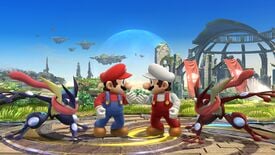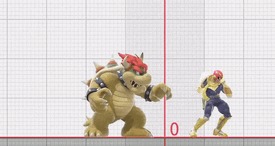| Welcome to SmashWiki! Log in or create an account and join the community, and don't forget to read this first! |
| Notices |
|---|
| The Skill parameter has been removed from Smasher infoboxes, and in its place are the new "Best historical ranking" and "Best tournament result" parameters. SmashWiki needs help adding these new parameters to Smasher infoboxes, refer to the guidelines here for what should be included in these new parameters. |
| When adding results to Smasher pages, include each tournament's entrant number in addition to the player's placement, and use the {{Trn}} template with the matching game specified. Please also fix old results on Smasher pages that do not abide to this standard. Refer to our Smasher article guidelines to see how results tables should be formatted. |
| Check out our project page for ongoing projects that SmashWiki needs help with. |
Stance mirroring
Stance mirroring is a mechanic in which most or all of a character's animations and moves are mirrored if they turn around, mimicking the sprite mirroring of older fighting games. This mechanic results in the characters' front side being visible more often. When mirrored, all hitboxes are also mirrored - for example, a punch that is animated with a character's right arm, when mirrored, will instead use the character's left arm.
In general, a character must have a symmetrical body shape and not wield a weapon in order to be eligible for stance mirroring, though in Ultimate characters who put away weapons when not in use (e.g. Villager's various tools) are generally not affected by this rule. Minor asymmetry such as Pikachu's tail and King K. Rool's eye tic can be acceptable, depending on their exact animations and hurtboxes. Compared to Smash 4, characters with stance mirroring in Ultimate are generally animated in a way that better accommodates the feature.
Stance mirroring also affects which hand characters use to hold, swing, and throw items. Turning around will cause a held item to simply teleport to the other hand (there is no animation for it). A fighter with stance mirroring that is reversed (for example, by Mario's Cape) can be seen in a non-mirrored position for a short time, and will soon instantly snap into the proper mirrored position.
As some characters mirror while others do not, it is possible for interactions to differ based on whether the characters are facing each other left-to-right versus right-to-left. For example, a mirroring character's thin attack may hit Marth's extended sword arm from one direction, but not the other, as the third dimension alters whether the two collide or pass by.
Stance mirroring is not present in games before Smash 4, though some special moves and many taunts in Melee and Brawl have a different animation for each direction to accomplish a similar effect.
The default facing direction is to the right, meaning characters are mirrored when facing left. Relatedly, characters without stance mirroring generally face the screen when facing right. The exceptions - those who instead face the screen when facing left - are Marth, Roy, Young Link, Toon Link, Pit, Lucina, Robin, Dark Pit, Chrom, Simon, Richter, and Sephiroth, as well as Link before Ultimate. Several of these are for consistency with the characters' home series; for example, Marth faces left in the battle scenes of Fire Emblem: Shadow Dragon and the Blade of Light and other games, while Simon's right-facing sprites from Castlevania are posed such that his torso faces away from the screen.


